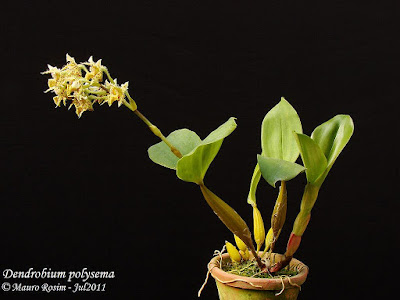Dendrobium polysema is native to Bougainville Island, Solomon Islands, Santa Cruz Islands, Vanuatu and Papua New Guinea. In New Guinea, these plants meet in the Western Highlands, Morobe and Northern Province...
Dendrobium polysema also called as The Many-Spotted Dendrobium, Dendrobium macrophyllum var stenopterum, Dendrobium polysema var. pallidum, Dendrobium pulchrum, Dendrobium stenopterum, Sayeria polysema, is a species of the genus Dendrobium. This species was described by Rudolf Schlechter in 1906.
IDENTIFY DENDROBIUM POLYSEMA
Dendrobium polysema is native to Bougainville Island, Solomon Islands, Santa Cruz Islands, Vanuatu and Papua New Guinea. In New Guinea, these plants meet in the Western Highlands, Morobe and Northern Province, where they grow on mossy trees in damp forests at 1200-1900 m, but on other islands they grow at heights of 150-700 m.
It is a small to large sized, hot to cool growing epiphyte, which reaching 20-65 cm in height, with erect, 3 to 5 noded below the leaves, yellow, 10-40 cm long stems carrying, 2, elliptical-oblong, erect to spreading, 10-24 cm long leaves.
The Many-Spotted Dendrobium blooms in fall till late winter and then in the spring on an erect, densely 8 to 12 flowered raceme that arises apical from the apex of a cane with open, flattened flowers. The flowers are 4-6 cm in diameter. The petals of both whorls are sometimes deeply wavy. Outer petals, densely covered with hairs on the underside, may be yellow or greenish with purple spots. The inner whorls have a cream color with chestnut spots. The area where the spots appear is very variable. The enlarged lip is gold with a greenish wand, which with age changes color to deep gold, then it fades. On the middle plot of the lip are purple dots, and purple stripes on side plots. The anther chamber is green.
DENDROBIUM POLYSEMA CARE AND CULTURE
Cultural information should only be used as a guide, and should be to be adapted to suit you. Your physical location; where you grow your plants, how much time you have to devote to their care, and many other factors, will need to be taken into account. Only then can you decide on the cultural methods that best suit you and your plants.
Light:
Dendrobium polysema needs a light level of 20000-30000 lux.
Temperature:
Throughout the year the average day temperature is 23-25 ° C, night 13-14 ° C, giving a daily difference of 10-13 ° C.
Humidity:
The Many-Spotted Dendrobium needs the average humidity of 70-75% throughout the year.
Substrate, growing media and repotting:
These plants can be mounted on tree ferns or cork, if the humidity is high and it is possible to water at least once a day in the summer. If you grow them in pots, you can use bark or any other, loose, fast-drying substrate. Repotting can be done when new roots begin to grow.
Watering:
In nature, precipitation is moderate to heavy throughout the year, but in winter for 1-2 months the conditions are a bit more dry. Dendrobium polysema should dry a little between waterings.
Fertilizer:
Weekly or every 2 weeks use of a 1/4-1/2 dose of orchid fertilizer is recommended. Balanced fertilizer should be used for a year round.
Rest period:
In winter, the amount of water and fertilizer needs to be slightly reduced, especially when Dendrobium polysema is grown in the conditions of a short, dark day at moderate latitudes. However, these plants should not completely dry out.















COMMENTS